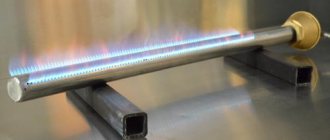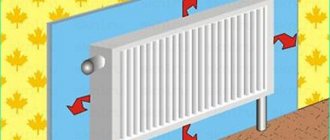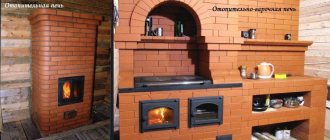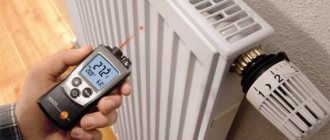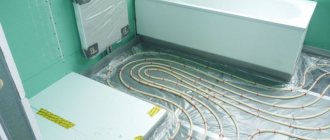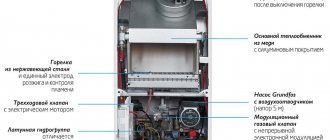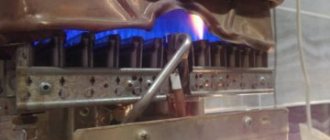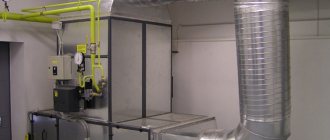Nowadays, it is impossible to imagine your life without ventilation systems. They are installed in industrial buildings, offices, educational institutions, shops, and apartments. The operation of these systems is unthinkable without the use of exhaust fans of various capacities. A widespread element of apartment ventilation is the kitchen hood. It can have different shapes, sizes, designs.
The amount of purified air in the room will depend on the calculation of the power of the kitchen hood fan.
How to find out the fan performance
Modern fan
When purchasing a ventilation device, everyone wants to know and check its performance. The productivity of the described device is the volume of air pumped over a certain unit of time. That's why everyone wants to buy a device with more performance! It is measured in “CFM”, which means cubic feet per minute or m³ (cubic meters) per hour.
An equally important characteristic of this device is its power, which is measured in “kW” and “kW”. In this case, the variable value is the rotation speed, measured in the number of revolutions produced per minute.
Calculation of the fan, or rather its performance, also involves:
- blade diameter;
- noise level;
- full pressure.
The fan performance is indicated on the packaging of the device or stated in the instructions supplied with it. Normally, such a device refreshes the air in the room every 4 minutes. An important indicator is the volume of available space. The larger it is, the greater the load on the described device. By the way, you can calculate the volume of a room where you need to “renew the air” using a simple school formula: multiplying the height by the width and length!
The required shift rate recommended by SNiP is the range from 10 to 12 times per hour. By multiplying the available volume of the room by any value from this range, you can obtain the required performance in a separate room. By summing the resulting value with calculations of the area for all rooms of the house, you can find out the required productivity for the entire living area.
In practice, the standards required by calculations are rarely implemented, so in real conditions everything is somewhat different, which concerns good air flow. So, for the minimum established rate of air exchange in a room, it is enough to open a window or rely on the draft created in the ventilation duct.
Kitchen exhaust fan
Bathrooms and kitchens require fans with higher performance or they must run longer here than in other rooms, since taking a shower and cooking leads to a change in the composition of the air, saturating it with water vapor and carbon monoxide. For such rooms, the operation of the device in a “reinforced hood” is suitable, which must be installed on the device.
An important role is played by the installation of an axial fan, which is a bladed blower that transmits mechanical energy from the rotation of the blades located on the impeller in the form of kinetic and potential energy. Calculation of the air exchange of axial fans is carried out taking into account the efficiency (efficiency factor), aerodynamic characteristics of the device and unit performance. This value may also be indicated in the instructions supplied with the device.
general description
Fans are machines designed to move various air-gas mixtures with an increase in their pressure to a maximum value of 12-15 kPa. Distinctive features of the fans are a simple single-stage design and operation at low peripheral shaft speeds. Fans consist of a housing, an impeller with blades mounted on a shaft inside the housing, and a drive. Electric motors are used to drive fans.
Fans are widely used both in everyday life and in industry. Industrial fans are subject to certain requirements due to more stringent operating conditions. In addition to compliance with the parameters of the ongoing technological process, industrial fans must meet high requirements for design reliability and safety.
Fans are used to transport various air-gas mixtures, which may differ in critical temperatures, abrasive properties, dust and moisture content. Therefore, an essential criterion in the manufacture of fans is the correct choice of material design.
How to increase fan performance
The presence of fresh air in the premises is the key to good work and excellent well-being of all household members. This can be organized by installing fan equipment in the room that can evenly cool the room. At the same time, its quiet operation, which does not create discomfort for others, is important.
It is desirable to create an unimpeded flow of air from the ceiling to the floor, which could be freely distributed around the entire perimeter of the room. Thanks to this, the device will heat up less and its performance will increase.
From a school physics course we know that cold air occupies the bottom of the room, and hot air occupies the top. Therefore, it is recommended to install an air outflow at the bottom of the room. The presence of active air outflow and inflow requires the installation of exhaust/injection fans of equal performance.
Ventilation system
You can increase the performance of the fan by switching it to efficient operation mode. In this case, the operation of the device should be minimal when household members are not at home. In other situations, it is recommended to increase the air supply in the room where people are. If there is an active cooking process in the kitchen and the shower is running for a long time, it is recommended to increase the local air supply in these rooms to the maximum. Such “smart” ventilation can quickly and efficiently exchange air in any room.
For the described ventilation system, a special control unit is equipped, which is connected to the processor. Sensors that can detect:
- degree of movement;
- amount of carbon dioxide;
- relative air humidity.
Responsible for the selected operating mode is the “control unit”, which sets the operating mode for the exhaust pumps. These devices can serve one or several rooms. The number of such devices depends on the area of the room. The hood from the kitchen is also connected here.
Kitchen hood
The advantage of using the described “smart” ventilation system is the correct regulation of the performance of exhaust fans, allowing you to reduce the amount of air pumped over 24 hours by almost half. It also consumes less electricity, which is a big plus for family budgets.
Air change rate
The multiplicity for premises of different types is determined as follows:
| Room type | Multiplicity |
| Bakery | 20-30 |
| Greenhouse | 25-50 |
| Office | 6-8 |
| Bathroom, shower | 3-8 |
| Salon | 10-15 |
| Restaurant, bar | 6-10 |
| Bedroom | 2-4 |
| Lobby | 3-5 |
| Classroom at school | 2-3 |
| Cafeteria | 10-12 |
| A hospital room | 4-6 |
| Shop | 8-10 |
| Basement | 8-12 |
| Kitchen in a house or apartment | 10-15 |
| Gym | 6-8 |
| Attic space | 3-10 |
| Catering kitchen | 15-20 |
| Pantry | 3-6 |
| Changing room with shower | 15-20 |
| Laundry | 10-15 |
| Toilet in the house, in the apartment | 3-10 |
| Conference hall | 8-12 |
| Living room | 3-6 |
| Billiard room | 6-8 |
| Public toilet | 10-15 |
| Garage | 6-8 |
| Meeting room | 4-8 |
| Utility room | 15-20 |
| Library | 3-4 |
| Dining room | 8-12 |
Table for calculating the minimum performance of the hood relative to the volume of the kitchen.
The highest multiplicity is chosen for use in rooms with many people, high humidity and temperature, a lot of dust and strong odors. In a kitchen with an electric hob, you can choose a lower indicator, with a gas stove - a higher one. This is due to the fact that gas emits combustion products when the stove is turned on. The fan, selected taking into account the above data, can be mounted in a wall, window, or ceiling of the room.
How to measure fan performance
A lot depends on the performance of the ventilation system: both the condition of the house and its general well-being. Thus, constant ventilation of the home by opening windows leads to condensation on the windows and walls, and also stimulates the formation of mold in the corners. An insufficient supply of fresh air negatively affects the condition of human lungs, manifesting itself in the development of corresponding diseases and pathologies. Children growing up without ventilation can compromise their health for the rest of their lives.
To measure the performance of a ventilation system, you can use the following methods:
Measuring room parameters
- Self-measurements. Using a tape measure, measure the size of the room, determining its volume in meters. You can use a simple school formula to calculate the area of a room: the product of height, width and length. The result obtained should be expressed in meters, which will be the total volume of the room.
- Obtaining information from reliable sources. BTI documents contain all the necessary information about the area of premises. The volume of all housing and heated area is given there. You can also find the height from ceiling to floor and calculate the volume of a separate room.
Next, the value characterizing air exchange is calculated. In this case, the volume of a separate room should be multiplied by the required number of air updates occurring within an hour. The number of air updates can be found in building codes and regulations (SNiP).
In this case, you should take the maximum number of updates in order to more accurately calculate the required power of the exhaust duct.
At home, the required ventilation device is selected based on the resulting air exchange area. Standard ventilation ducts have a low air exchange capacity. The situation can be helped by installing a recirculation exhaust system that can pass air through filters, sending it back into the room.
Scheme of installation of natural and forced ventilation
If the house does not have a ventilation duct, then the exhaust fan can be installed in a wall opening or on the ceiling. The junction of the ceiling and wall is also suitable for these purposes. In this case, you can install a device with a lower power value.
Calculation of operating pressure and cross-sectional area of air ducts
In this case, it is necessary to draw up a ventilation network design, which should include oxygen distributors (grills and diffusers), fittings and air ducts. If calculated correctly, the operating pressure will depend on the operating characteristics of the fan, the cross-section and shape of the ventilation pipes, as well as the number of transitions.
To calculate the required pipe diameter, you can use the following relationship:
- for a residential building - for 1 m² of area you need to use a pipe with a cross-sectional area of 5.4 cm²;
- for garages - 17.6 cm² section is taken per 1 m².
The oxygen flow rate also depends on the cross-section of the pipes. In most cases, the speed is chosen to be no less than 2.4 m/s and no more than 4.2 m/s.
Calculating ventilation is a rather complex process that depends on many factors. Therefore, if you are not completely confident in your abilities, it is better to seek help from specialists.
Exhaust ventilation in the kitchen
Thanks to kitchen exhaust ventilation, it is possible to carry out air exchange in the most problematic areas of the room. For example, improving the air quality in the kitchen during food preparation. Not only the general well-being of the people living here, but also the condition of the walls in the living space depends on the use of such structures. Technical standards recommended by SNiP for organizing ventilation:
- 60 m³ per hour (electric stove);
- 100 m³ per hour (gas hobs).
This value should be multiplied by the area of the room to find out the required performance of the ventilation system. It is based on the obtained value that a device with an appropriate electric motor should be selected. Installing a hood above the hob allows for additional air exchange, preventing the spread of food aromas throughout the home. When connecting these elements, you should select all components correctly, with equal sections.
When the kitchen hood is installed correctly, the ventilation shaft with the attached device is connected. Thanks to this, the harmful chemical compounds formed during cooking are completely removed from the component.
Principle of operation
The air supply and exhaust system has a certain operating principle. In it, air masses are artificially forced into the room by means of a fan. As a result, a difference in pressure is obtained and the “exhaust” air, trying to spontaneously adjust this imbalance, comes out through special exhaust air ducts.
Basically, exhaust fans are mechanisms where the impeller is located on the same shaft with an electric motor. The air stream is sucked inside through a grille with blinds, which sometimes acts as a check valve.
Exhaust devices of this type are usually installed in windows, but sometimes, if there is a small air duct and insufficient exhaust, certain products are built directly into the wall. If a long air duct is installed, centrifugal fans are used. In them, the air stream is directed perpendicular to the motor shaft.
Exhaust mechanisms can operate manually or automatically. In the first case, to start the mechanism you need to turn it on using the switch. And in the second, the product will start working when certain conditions are reached. These may be: the occurrence of a set humidity level, the turning on of a light bulb, or the end of a specified time range.
And also, when manually setting the hood, it is possible to turn on the heating in winter, when it is turned off in summer, which naturally saves energy. To heat the incoming air mass, a special heat exchanger is used - a recuperator. This mechanism works on the principle of mutual heating, that is, the outgoing air flow heats the air entering the room. At the same time, they move in isolation, and mixing does not occur.
Why did you choose a recuperator?
For reference: unlike conventional fans, an enthalpy recuperator allows for rational heat exchange between the supply and exhaust flow of the ventilation system. During its operation, part of the heat from the exhaust air flow is transferred to the supply air flow, which creates a comfortable microclimate in the room and at the same time reduces the cost of heating it. On hot summer days, heat exchange occurs in the opposite direction, which also plays into the hands of the owner of the room. At the same time, the dry supply flow is saturated in the heat exchanger with moisture contained in the already exhausted air. The presence of the above functions fully explains the choice of such an air handling unit.
We present a functional diagram of the installation.
- M1 and M2 – supply and exhaust fans;
- D (1, 2, 3) – temperature sensors;
- K (1, 2, 3) – heat exchangers;
- F (1, 2) – air filters.
Recommendations for additional functionality
It is important to choose a recuperator for your home that has sensitive and reliable automation. After all, there is nothing worse than equipment that is constantly involved in work and requires attention with enviable regularity. Modern recuperators can be equipped with additional systems and options:
- automatic fan power control system;
- automatic air flow control system (regulates the air flow pressure depending on the carbon dioxide content in the exhaust duct);
- weekly timers, etc.
This also includes an improved filtration system.
READ How to replace a mixer for whipping cream
What kind of fan do you need, in the presence and absence of natural ventilation.
There are also systems with which units are equipped optionally. For example, for operation in special climatic conditions (at low or, conversely, high temperatures). Installing additional heaters, coolers, humidifiers or supply air dehumidifiers in this case can become a vital necessity.
If the recuperator itself cannot maintain the required supply air temperature, then the device should be retrofitted with a heater of appropriate power. On average, if the calculated temperature in the channel does not fall below 14.15°C, then the heater does not need to be installed. My opinion is this: it is better not to turn on the heater if it is not needed, than when it is needed, there will be nothing to turn on.
The above systems and devices make it possible to minimize human participation in system management and improve the quality of operation of the ventilation system. Also, thanks to them, it is possible to reduce the cost of operating the installation by temporarily or partially disconnecting individual rooms from the ventilation system. Disabling is carried out in accordance with the equipment settings.
Currently, there are models of recuperators that are capable of connecting to individual Smart Home systems using the ModBus or KNX protocols. Such devices are ideal for connoisseurs of advanced and modern functionality.
Normative documents
This type of service such as ventilation is strictly regulated by standards. The key requirements are contained in SNiP 41-01-2003. According to the developers of the law, it regulates:
- environmental indicators;
- impact on the environment in the building;
- fire safety level;
- energy saving;
- operational stability under design conditions.
All these points must be strictly observed, regardless of the specific format of ventilation and the range of tasks that it must perform. Recently, more and more attention has been paid to improving mechanical ventilation and its connection with air conditioning systems. The creators of SNiP relied on the provisions of GOST:
- acoustic safety (12.1.003-83);
- air properties in working and living spaces (12.1.005-88);
- Standard cross-sectional dimensions for pneumatic equipment (24751-81);
- Microclimate in residential and office buildings (30494-96).
The standard requirement for the air supplied to the cabins is to warm it up to at least 15 degrees Celsius in winter. In public buildings and administrative premises a minimum of 12 degrees Celsius is required. And when making canopies, air supply at a temperature of less than 5 degrees Celsius is not allowed. Design specifications may allow for lower air temperatures during colder seasons. All piping must be installed only in such a way that it can be easily repaired or replaced.
All openings for air intake devices must be located at a height of at least 1 m above a stable snow line. This parameter should be determined taking into account data from meteorological services monitoring weather conditions in a particular area. In the event of sandstorms, it is necessary to surround these chambers with devices that retain harmful particles. Air intake systems must be separate for each fire compartment. When calculating air requirements, the highest values are taken as the basis.
READ How to assemble a Vitek 1934 fan
Design
The ease of assembly and availability of structural elements are the reason why radial fans are assembled not only in factories, but also at home. After all, industrial assembly, although it has a quality guarantee, is not always available in the price range and in the required configuration for small residential or utility rooms.
The design of a standard centrifugal fan requires the presence of:
The dimensions of the scroll, engine power, rotation angle and shape of the blades and other features depend on the scope and specific conditions of application.
